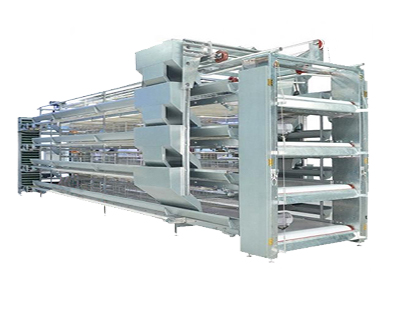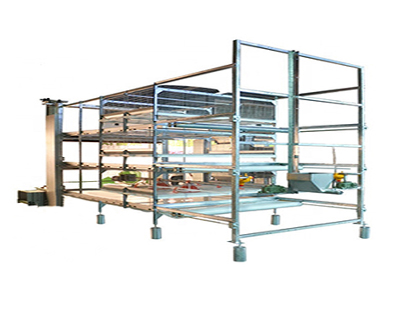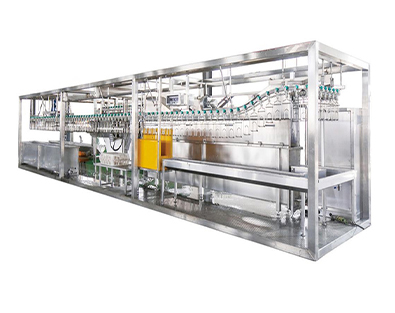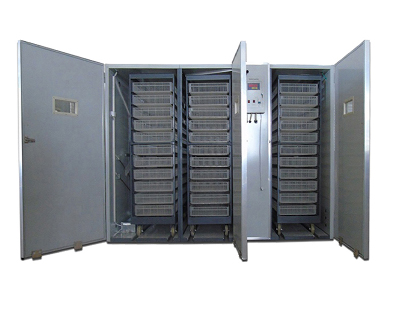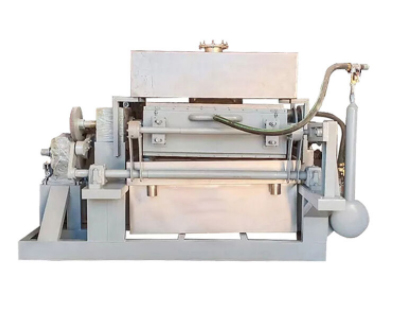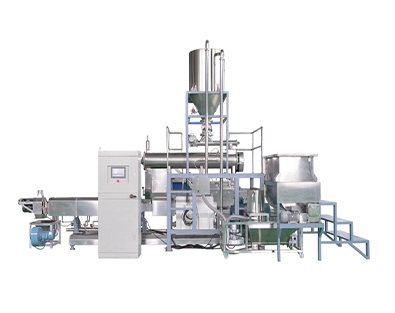
Basic information
Layer birds kept in battery cage, eating a normal ratio and laying at a rate of 80%, will produce about 180 kilocalories of heat every day. Thus 10,000 layers will produce as much heat in a day as a furnace burning 231 litres of fuel oil, this means that on a warm summer day, a ventilation failure could result in a rise in the temperature, within the building, of 16°C in one hour. When the hen is in a comfortable environmental temperature (21-25°C) she will lose most of that heat by sensible means. Sensible heat loss is by three pathways
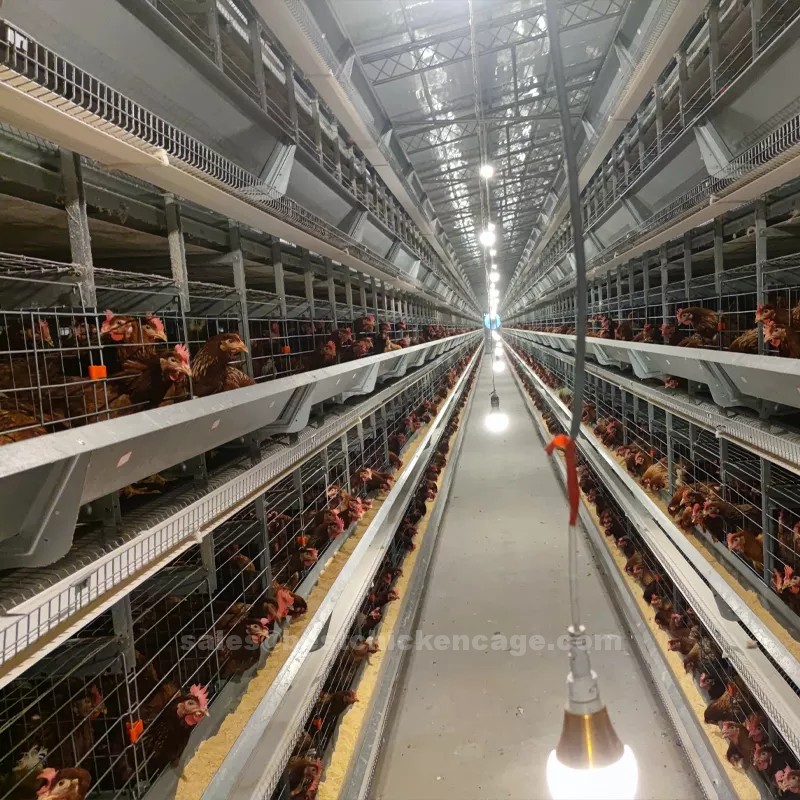
Regulation of heats in battery cage
1. Conduction, whereby she touches a surface cooler than her own surface, for example the floor of the cage or the sides of a cool water trough;
2. Convection, whereby a cool breeze carries heat from her body; and
3. Radiation, the electromagnetic process whereby heat moves from a warmer to a cooler surface without using a medium (heat flows to the earth from the sun by radiation)
Series of products to serve the poultry farm fully, click the name to learn more
1. Steel structure poultry house, opening type for hot countries and close type for cool countries
2. Poultry hatching equipment’s capacity of eggs up to 120,000+ to be hatching house
4. Chicken feed processing equipment from feed crushing and mixing to stock to feeding chicken
6. Egg processing equipment from automatic egg collection to packing egg to trays
7. Chicken slaughtering equipment from slaughter to vacuum package
9. Other poultry farm equipment are coming soon...
Bookmark our website and contact us now to discuss your modern poultry farm plan and quotation
Processes
When the laying hen in battery cage is in a very warm environment (28-35°C) she must work at losing the heat she produces. She does so by raising and spreading her wings and separating herself from other birds if possible. Despite her best efforts, however, heat loss by sensible means decreases and loss by latent means (evaporation) increases
One reason is that, as the environmental temperature increases, the difference between the temperature of the hen's body (41°C) and the surrounding air, equipment and walls becomes very small. Thus she cannot readily lose heat by sensible means and must do so by evaporation. A second reason is that the evaporation of water uses a lot of heat - it is an effective way for her to keep cool
How does she go about evaporating water since she does not have sweat glands? She does it by panting, similar to the dog. The hen can easily increase her respiration rate to 10 times normal and, in addition, indulges in gular (throat) flutter to aid in evaporation. One can readily see the rapid throat movement in panting birds. This throat flutter moves air in and out of the throat area and increases evaporation without such air entering the lungs.
During a hot, dry day this is very efficient but on a hot, humid day the hen must pant more to keep cool. This evaporation means that a readily available supply of clean, fresh water is vital. The heat from the laying hen, either in sensible or latent form, must be removed from the building
Procedures
Feed and lighting in battery cage
1. During hot weather it is extremely important to monitor feed consumption of layers raised in battery cage daily, to ensure an adequate intake of nutrients per bird on daily basis. This is particularly important for the 24 to 30 week old pullet. Special feed formulations do exist for summer feeding. Consult your feed company for details. Stirring existing feed within the trough by operating feed lines between feedings helps increase consumption. Running the feeders early in the morning will stimulate feed consumption during the cooler hours of the day
2. The lighting system time clocks should be set to come on in the early morning, cooler hours, i.e. before morning
Ventilation system management in battery cage
1. Air-inlet baffles must control the inlet air to provide proper air movement, even distribution and proper house static pressure. Automatic baffle controllers using a static pressure sensor are recommended. Without automatic baffle control, adjust inlet baffles to keep the house static pressure within an acceptable range as fans turn on and off
2. A heat stress problem can occur any time during the year if the ventilation system fails to work properly. In winter when large fans are covered and outside doors on air-intakes are closed, it is important to ensure that there is adequate back-up fan capacity to cool the barn. An equipment failure at this time is just as serious as in the summer. Check the high temperature warning system regularly year round and be especially sure that winter fans are in working order
Our services
1. We give adequate instructions to our customers to ensure accurate temperature in battery cage
2. We ensure that our engineers put our customers through on how to use our products
3. We emphasize precautions on any of our equipment customers are purchasing
4. We do follow up to see how effectives our equipment are working
Frequently ask questions
Q: How do you reduce heat stress in chicken?
A: Ensuring cross ventilation is the key factor
Q: How does battery cage system work?
A: Battery cage keep poultry birds safe
Q: What is the importance of controlling heat in battery cage?
A: It aids egg production in laying birds and aids rapid growth in broilers
Q: Does heat affect egg production?
A: It does greatly affect the rate at which layers lay eggs
Message
Products recommended
 Steel poultry houseEquipment used for rearing layers, broilers and day old chick in a closed steel poultry houseMore
Steel poultry houseEquipment used for rearing layers, broilers and day old chick in a closed steel poultry houseMore Layer rearing equipmentThe environmental control system monitors the environmental data of the chicken shed constantly based on temperature and humidity sensor data. It controls the cooling fans, cooling pads and the clear story automatically by a microcomputer integrated systemMore
Layer rearing equipmentThe environmental control system monitors the environmental data of the chicken shed constantly based on temperature and humidity sensor data. It controls the cooling fans, cooling pads and the clear story automatically by a microcomputer integrated systemMore Chick rearing equipmentThe environmental control system monitors the environmental data of the chicken shed constantly based on temperature and humidity sensor data. It controls the cooling fans, cooling pads and the clear story automatically by a microcomputer integrated systemMore
Chick rearing equipmentThe environmental control system monitors the environmental data of the chicken shed constantly based on temperature and humidity sensor data. It controls the cooling fans, cooling pads and the clear story automatically by a microcomputer integrated systemMore Broiler rearing equipmentThe environmental control system monitors the environmental data of the chicken shed constantly based on temperature and humidity sensor data. It controls the cooling fans, cooling pads and the clear story automatically by a microcomputer integrated systemMore
Broiler rearing equipmentThe environmental control system monitors the environmental data of the chicken shed constantly based on temperature and humidity sensor data. It controls the cooling fans, cooling pads and the clear story automatically by a microcomputer integrated systemMore Chicken slaughtering equipmentThis machine is made of stainless steel, equipped with non-power rotational rollers.More
Chicken slaughtering equipmentThis machine is made of stainless steel, equipped with non-power rotational rollers.More Manure processing equipmentChange deodorization device can avoid wasting electric power which saves about 300kw per hour each day. It is cost-effective and environment friendly. We have three ways for buyers' option to solve the gas and smell problem. All the options are to reduce cost and protect the environmentMore
Manure processing equipmentChange deodorization device can avoid wasting electric power which saves about 300kw per hour each day. It is cost-effective and environment friendly. We have three ways for buyers' option to solve the gas and smell problem. All the options are to reduce cost and protect the environmentMore Egg hatching equipmentIt separates the hot environment of the cabinet from the external environment and prevents the outside air from entering the cabinetMore
Egg hatching equipmentIt separates the hot environment of the cabinet from the external environment and prevents the outside air from entering the cabinetMore Egg tray equipmentTurn wastepaper,such as old newspaper,magazines and cartons,into pilp of certain consistency through pupling,screening,and additive chemical application for forming ,main equipments, pulper, pulp tank,water tank,pipe pump,water pump,agitator consistency controller,control cabinet,etcMore
Egg tray equipmentTurn wastepaper,such as old newspaper,magazines and cartons,into pilp of certain consistency through pupling,screening,and additive chemical application for forming ,main equipments, pulper, pulp tank,water tank,pipe pump,water pump,agitator consistency controller,control cabinet,etcMore Feeding processing equipmentThis equipment can mix material,water and other additives.It's the first step of food processingMore
Feeding processing equipmentThis equipment can mix material,water and other additives.It's the first step of food processingMore
By clicking 'Allow All', you agree to the storage of cookies on your device to enhance site navigation, analyze site usage and assist with our marketing efforts.


